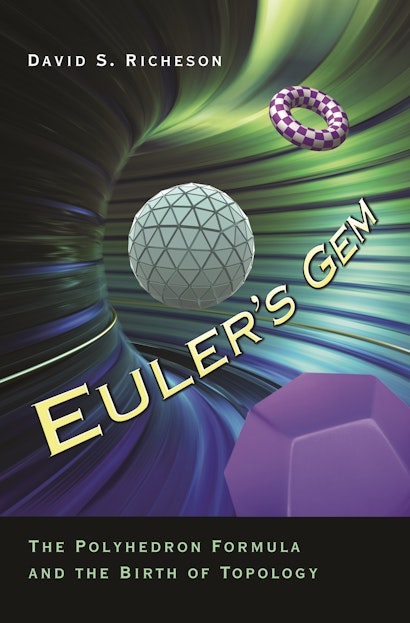Leonhard Euler’s polyhedron formula describes the structure of many objects—from soccer balls and gemstones to Buckminster Fuller’s buildings and giant all-carbon molecules. Yet Euler’s formula is so simple it can be explained to a child. Euler’s Gem tells the illuminating story of this indispensable mathematical idea.
From ancient Greek geometry to today’s cutting-edge research, Euler’s Gem celebrates the discovery of Euler’s beloved polyhedron formula and its far-reaching impact on topology, the study of shapes. In 1750, Euler observed that any polyhedron composed of V vertices, E edges, and F faces satisfies the equation V-E+F=2. David Richeson tells how the Greeks missed the formula entirely; how Descartes almost discovered it but fell short; how nineteenth-century mathematicians widened the formula’s scope in ways that Euler never envisioned by adapting it for use with doughnut shapes, smooth surfaces, and higher dimensional shapes; and how twentieth-century mathematicians discovered that every shape has its own Euler’s formula. Using wonderful examples and numerous illustrations, Richeson presents the formula’s many elegant and unexpected applications, such as showing why there is always some windless spot on earth, how to measure the acreage of a tree farm by counting trees, and how many crayons are needed to color any map.
Filled with a who’s who of brilliant mathematicians who questioned, refined, and contributed to a remarkable theorem’s development, Euler’s Gem will fascinate every mathematics enthusiast.
Awards and Recognition
- Winner of the 2010 Euler Book Prize, Mathematical Association of America
- One of Choice's Outstanding Academic Titles for 2009
"The author has achieved a remarkable feat, introducing a naïve reader to a rich history without compromising the insights and without leaving out a delicious detail. Furthermore, he describes the development of topology from a suggestion by Gottfried Leibniz to its algebraic formulation by Emmy Noether, relating all to Euler's formula. This book will be valuable to every library with patrons looking for an awe-inspiring experience."—Choice
"This is an excellent book about a great man and a timeless formula."—Charles Ashbacher, Journal of Recreational Mathematics
"I liked Richeson's style of writing. He is enthusiastic and humorous. It was a pleasure reading this book, and I recommend it to everyone who is not afraid of mathematical arguments and has ever wondered what this field of 'rubbersheet geometry' is about. You will not be disappointed."—Jeanine Daems, Mathematical Intelligencer
"The book is a pleasure to read for professional mathematicians, students of mathematicians or anyone with a general interest in mathematics."—European Mathematical Society Newsletter
"I found much more to like than to criticize in Euler's Gem. At its best, the book succeeds at showing the reader a lot of attractive mathematics with a well-chosen level of technical detail. I recommend it both to professional mathematicians and to their seatmates."—Jeremy L. Martin, Notices of the AMS
"I highly recommend this book for teachers interested in geometry or topology, particularly for university faculty. The examples, proofs, and historical anecdotes are interesting, informative, and useful for encouraging classroom discussions. Advanced students will also glimpse the broad horizons of mathematics by reading (and working through) the book."—Dustin L. Jones, Mathematics Teacher
"The book should interest non-mathematicians as well as mathematicians. It is written in a lively way, mathematical properties are explained well and several biographical details are included."—Krzysztof Ciesielski, Mathematical Reviews
"Euler's Gem is a thoroughly satisfying meditation on one of mathematics' loveliest formulas. The author begins with Euler's act of seeing what no one previously had, and returns repeatedly to the resulting formula with ever more careful emendations and ever-widening points of view. This highly nuanced narrative sweeps the reader into the cascade of interlocking ideas which undergird modern topology and lend it its power and beauty."—Donal O'Shea, author of The Poincaré Conjecture: In Search of the Shape of the Universe
"Beginning with Euler's famous polyhedron formula, continuing to modern concepts of 'rubber geometry,' and advancing all the way to the proof of Poincaré's Conjecture, Richeson's well-written and well-illustrated book is a gentle tour de force of topology."—George G. Szpiro, author of Poincaré's Prize: The Hundred-Year Quest to Solve One of Math's Greatest Puzzles
"A fascinating and accessible excursion through two thousand years of mathematics. From Plato's Academy, via the bridges of Königsberg, to the world of knots, soccer balls, and geodesic domes, the author's enthusiasm shines through. This attractive introduction to the origins of topology deserves to be widely read."—Robin Wilson, author of Four Colors Suffice: How the Map Problem Was Solved
"Appealing and accessible to a general audience, this well-organized, well-supported, and well-written book contains vast amounts of information not found elsewhere. Euler's Gem is a significant and timely contribution to the field."—Edward Sandifer, Western Connecticut State University
"Euler's Gem is a very good book. It succeeds in explaining complicated concepts in engaging layman's terms. Richeson is keenly aware of where the difficult twists and turns are located, and he covers them to satisfaction. This book is engaging and a joy to read."—Alejandro López-Ortiz, University of Waterloo


